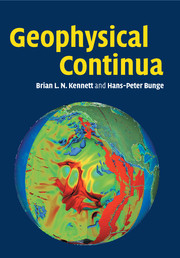Book contents
- Frontmatter
- Contents
- Preface
- 1 Introduction
- PART I CONTINUUM MECHANICS IN GEOPHYSICS
- PART II EARTH DEFORMATION
- 9 From the Atomic Scale to the Continuum
- 10 Geological Deformation
- 11 Seismology and Earth Structure
- 12 Lithospheric Deformation
- 13 The Influence of Rheology: Asthenosphere to the Deep Mantle
- 14 Mantle Convection
- 15 The Core and the Earth's Dynamo
- Appendix: Table of Notation
- Bibliography
- Index
11 - Seismology and Earth Structure
from PART II - EARTH DEFORMATION
Published online by Cambridge University Press: 17 March 2011
- Frontmatter
- Contents
- Preface
- 1 Introduction
- PART I CONTINUUM MECHANICS IN GEOPHYSICS
- PART II EARTH DEFORMATION
- 9 From the Atomic Scale to the Continuum
- 10 Geological Deformation
- 11 Seismology and Earth Structure
- 12 Lithospheric Deformation
- 13 The Influence of Rheology: Asthenosphere to the Deep Mantle
- 14 Mantle Convection
- 15 The Core and the Earth's Dynamo
- Appendix: Table of Notation
- Bibliography
- Index
Summary
The theory of linearised elasticity introduced in Chapter 5 provides the basis for understanding the behaviour of seismic waves except in the immediate vicinity of an earthquake fault or explosion. Once the incremental strains associated with wave disturbances drop below 10–5, the linearised treatment provides an effective description of the situation. The dominant variation in the properties of the Earth is with radius and the treatment of wave propagation in a spherically stratified Earth gives a useful reference. The complexities of the pre-stressed, three-dimensional Earth can then generally be addressed by a perturbation treatment about the reference state. Although most minerals are anisotropic, the incremental properties of the mineral aggregates in the Earth are close to isotropic. The complexities of anisotropic propagation are therefore needed only for limited regions, mostly in boundary or transition zones.
Seismic waves
In Chapter 5 we demonstrated the properties of plane elastic waves in a uniform medium, and illustrated the radiation from simple sources. For application to the Earth we need to take account of the variations in elastic parameters with depth, the presence of material interfaces, and energy loss through intrinsic anelasticity and scattering.
The waves exploited in seismology span a considerable range of frequencies. The longest period free oscillations of the Earth have a period close to an hour, whereas frequencies above 100 Hz can be employed in seismic exploration for shallow structure.
- Type
- Chapter
- Information
- Geophysical ContinuaDeformation in the Earth's Interior, pp. 207 - 256Publisher: Cambridge University PressPrint publication year: 2008



